Exam 2 BIOL 223 Tension Production
1/117
There's no tags or description
Looks like no tags are added yet.
Name | Mastery | Learn | Test | Matching | Spaced |
|---|
No study sessions yet.
118 Terms
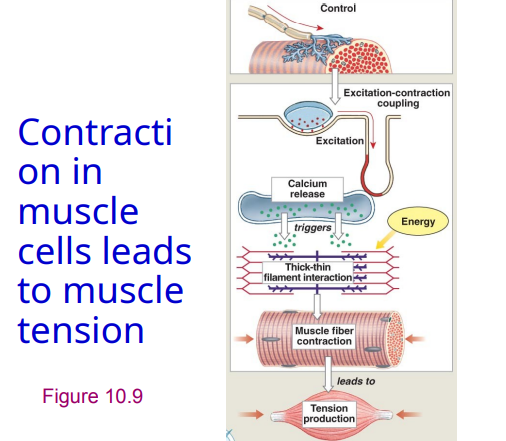
Contraction in muscle cells leads to muscle _____
tension
Tension is also known as what kind of strength?
Pulling strength
What causes sarcomere shortening?
The sliding of actin and myosin filaments
In a muscle cell, all sarcomeres shorten, which cause the _____ ___ to shorten
muscle cell
What does tension in a muscle depend on?
Tension that develops in individual muscle cells during contraction
Number of muscle cells that contract
The amount of muscle shortening depends on 2 factors. What are they?
Tension & Resistance
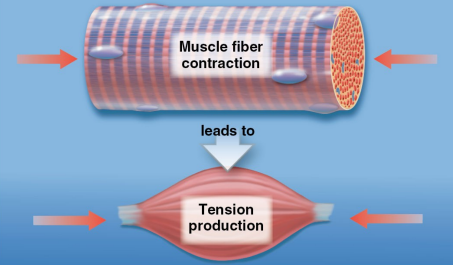
As sarcomeres shorten, muscle cell shortens, producing ____
Tension
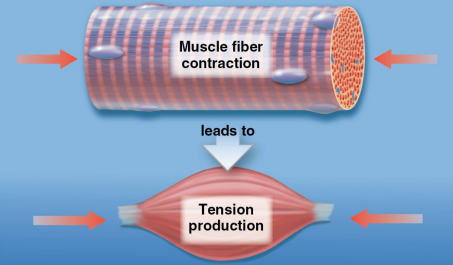
"Fiber shortening" describes the mechanism of muscle contraction, where the functional units of a muscle cell, called sarcomeres, become shorter. The overall result is that the entire muscle cell (fiber) shortens, generating tension that pulls on what?
pulls on the connective tissues and bones to which it is attached.
Why does tension produced in individual muscle fibers vary?
Length-tension relationship: The length-tension relationship describes how the force a muscle can generate is dependent on its length, primarily due to the overlap of actin and myosin filaments within its sarcomeres. Maximum tension occurs at an optimal length with maximal filament overlap, while shorter or longer lengths result in less force because of reduced or excessive filament interactions.
Frequency of stimulation by motor neuron (faster → more tension)
Why can tension produced by an entire muscle vary?
The number of muscle cells receiving nerve stimulation, commanding the entire muscle to contract
Muscle cells are grouped in motor units
In length-tension relationships, the amount of tension depends on the number of
cross bridges formed. It depends on the overlap of actin & myosin filaments
A skeletal muscle contracts most forcefully over a
narrow range of resting because this length provides the optimal overlap between actin and myosin filaments to generate the maximum number of cross-bridges.
When a muscle is stretched too far, the overlap decreases, reducing the number of cross-bridges that can form and thus lowering tension.
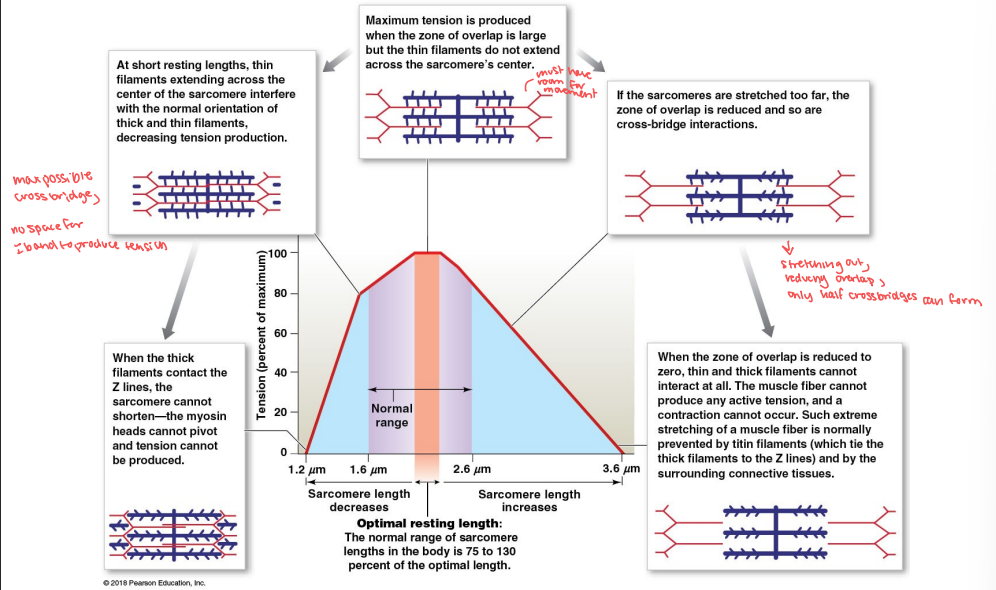
When is maximum tension produced?
When the zone of overlap is large but the thin filaments do not extend across the sarcomere’s center.
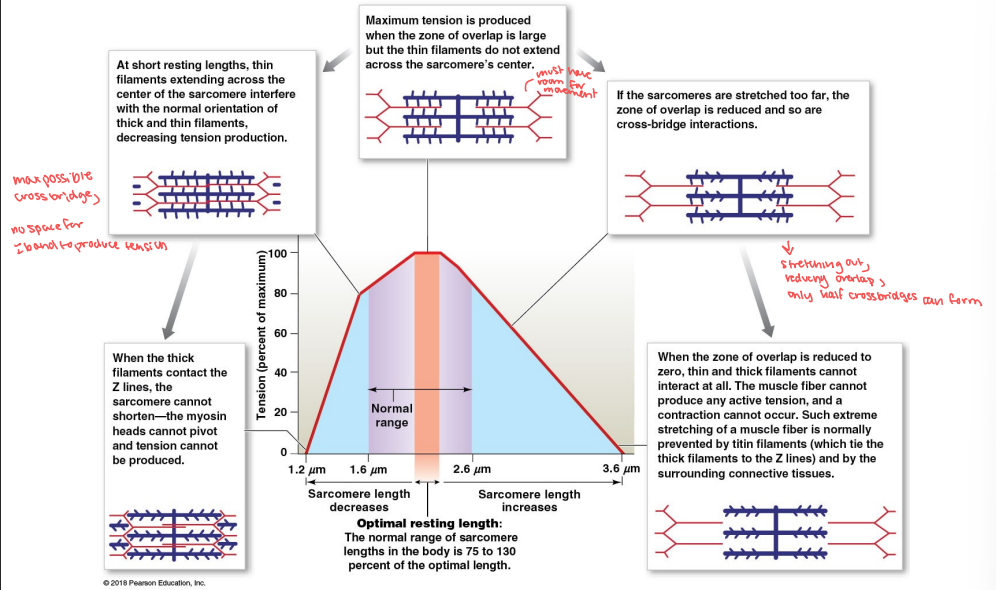
If sarcomeres are stretched too far, what happens to the zone of overlap?
The zone of overlap is reduced and so are cross-bridge interactions. When you stretch out, you reduce overlap which only allows half of crossbridges to form.
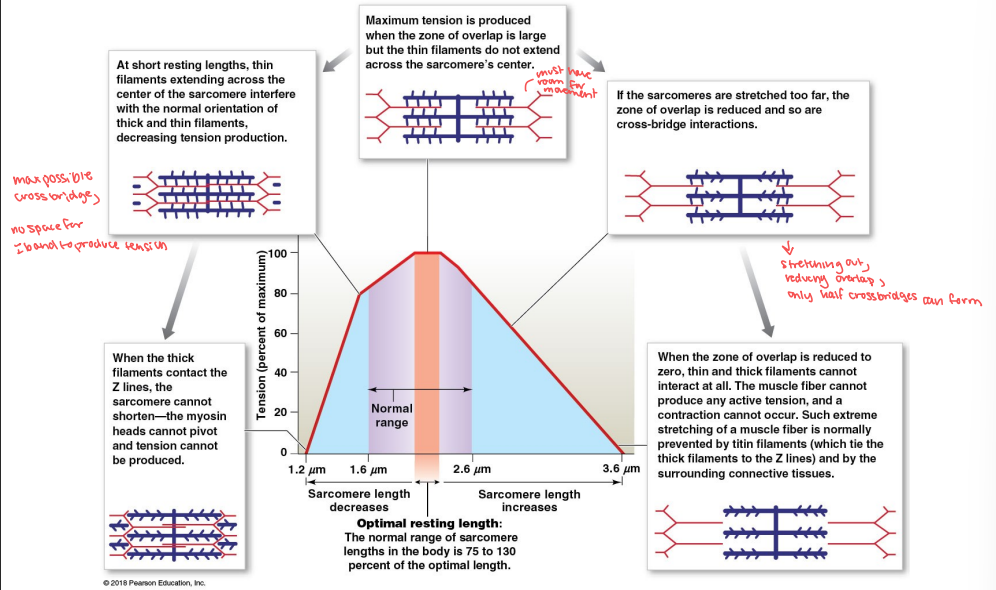
When the zone of overlap is reduced to 0, will thin and thick filaments be able to interact? Why or why not?
No. Thin and thick filaments cannot interact at all. The muscle fiber cannot produce any active tension, and a contraction cannot occur.
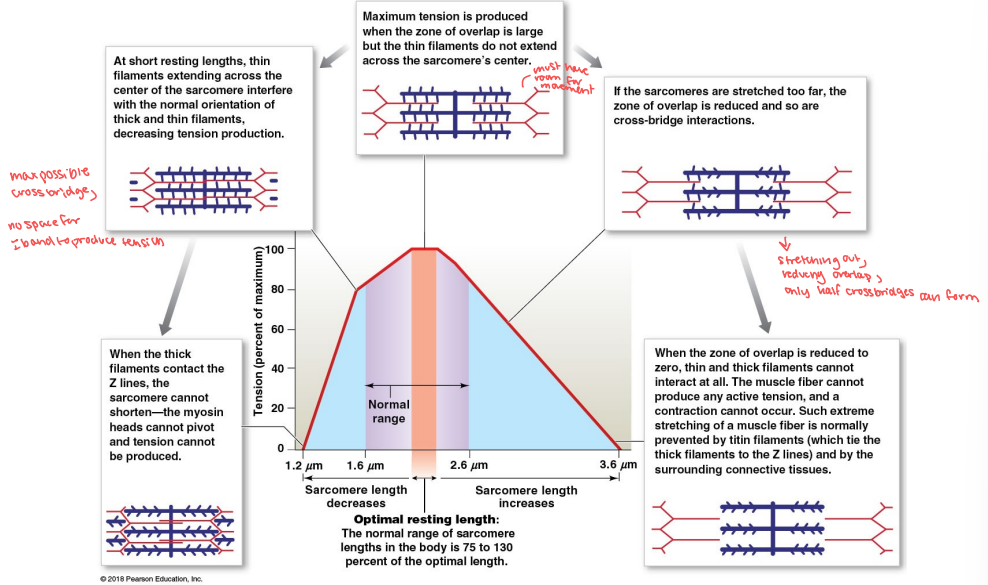
Such extreme stretching of a muscle fiber is normally prevented by ___ filaments, which tie the thick filaments to the z lines, and by the surrounding connective tissues.
titin
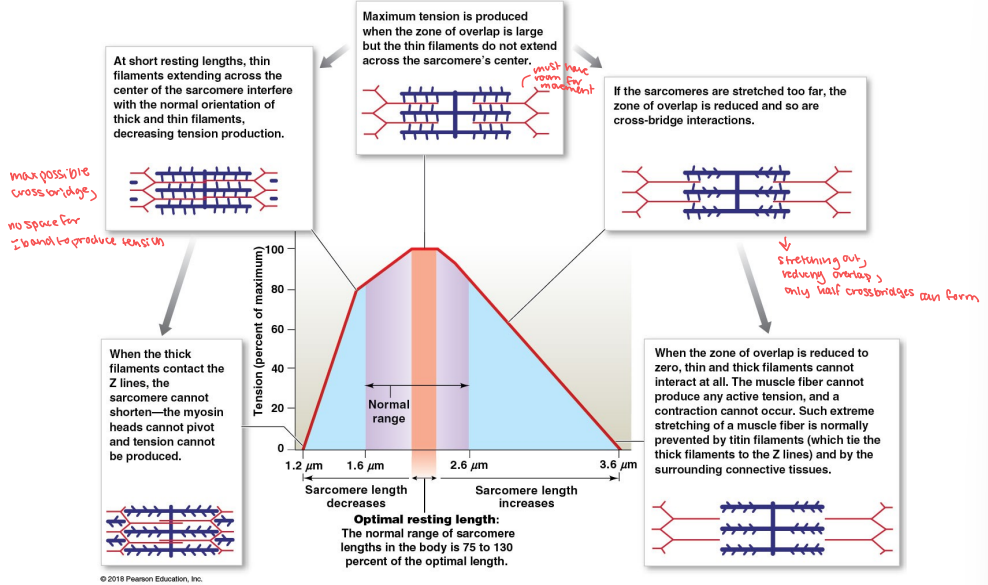
The normal range of sarcomere lengths in the body is what % of optimal length?
75-130% of the optimal length.
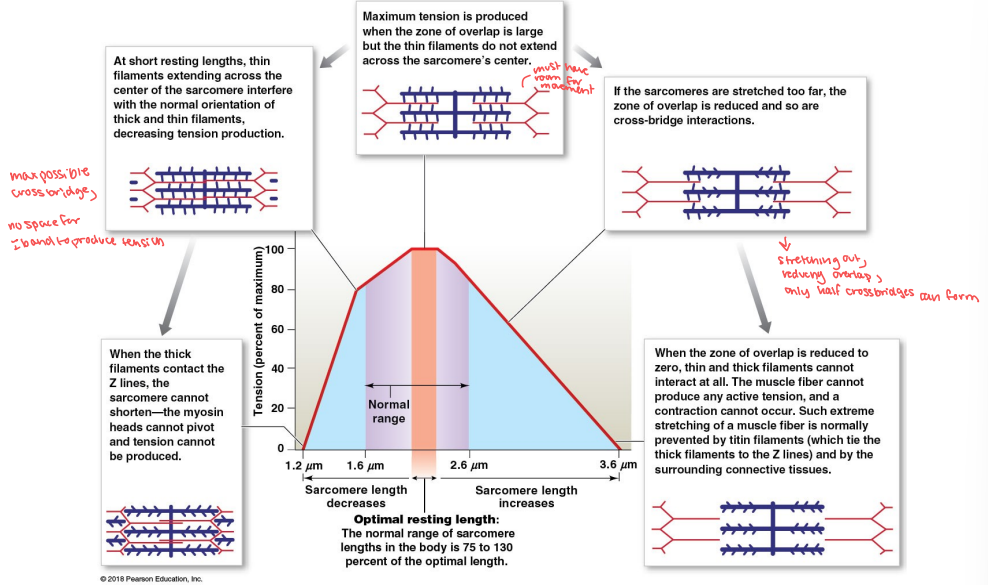
At short resting lengths, thin filaments across the center of the sarcomere interfere with the normal orientation of thick and thin filaments, which decrease what?
Tension production. The more possible cross bridges, the less space there is for the I band to produce tension.
This happens because the overlap between thick and thin filaments becomes so extensive that there is no room for further movement, or the filaments begin to collide with each other, resulting in reduced tension.
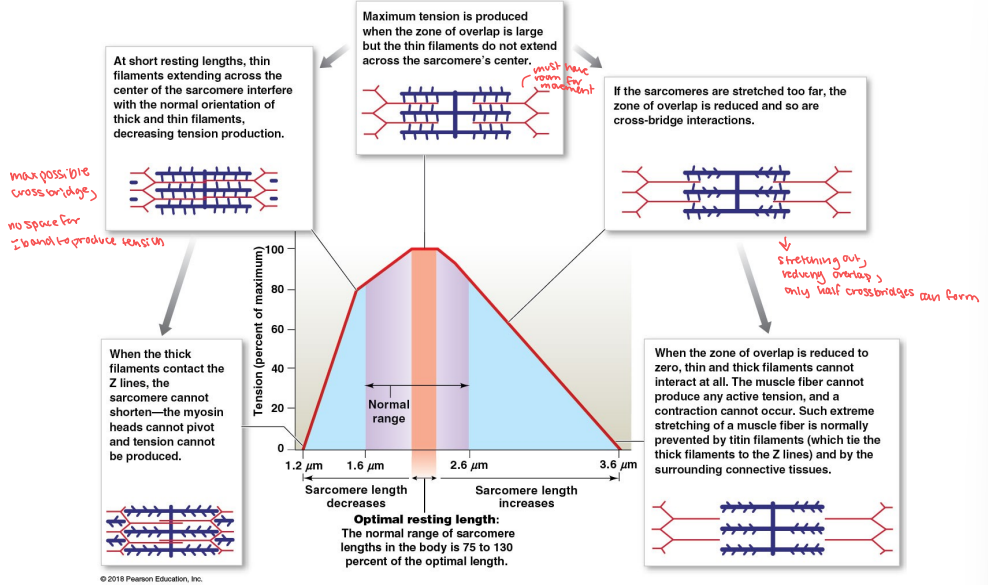
When the thick filaments contact the Z lines, the sarcomere cannot shorten— the myosin heads cannot pivot. Therefore, what cannot be produced?
Tension
What is a twitch?
A cycle of contraction & relaxation produced by a single action potential in a muscle cell.
A twitch is a cycle of contraction & relaxation. How is it produced in a muscle cell?
By a single action potential.
T/F: A twitch is produced by several action potentials in a muscle cell.
F, a twitch is produced by a single action potential in a muscle cell.
T/F: A twitch is not typical of most normal skeletal muscle activity.
T
T/F: A twitch is typical of most normal skeletal muscle activity.
F. it is not typical.
Describe the latent phase of a twitch.
Latent phase — action potential occurs
No contraction until Ca2+ is released from SR
What are all the phases of a twitch (just name)?
Latent phase
Contraction phase
Relaxation phase
Describe the contraction phase of a twitch.
Tension rises to peak
Ca2+ moves tropomyosin off actin active sites
Myosin cross bridges form, actin is pulled
Describe the relaxation phase of a twitch.
Tension falls to resting levels
Ca2+ is pumped back into SR
Actin sites covered by tropomyosin
No cross bridges remain
Most muscular activities involve sustained muscular contractions. What does this mean?
Sustained muscular contractions mean that muscles are held in a state of tension for a prolonged period, as opposed to brief, jerky movements.
i.e. youre not gonna pick up a weight and let it go immediately right
Most muscular activities involve sustained muscular contractions. How are they produced?
Produced by high frequency of action potentials in muscle cell
Produced in response to high frequency of action potentials in motor neuron (high frequency of stimulation)
Most muscular activities involve sustained muscular contractions. The ______ of tension produces greater tension.
summation. it adds up the effect of action potential on the muscle, which directly affect the release of Ca2+ from SR → attach to troponin
What is summation?
Repeated stimulation produced before relaxation phase has been completed
What is the summation of tension caused by?
The build up of calcium ions in the sarcoplasm
What is complete tetanus?
The maximum tension production in a muscle cell - maximum cross bridge formation
The maximum tension production in a muscle cell - maximum cross bridge formation - is termed
complete tetanus
The build up of calcium ions in the sarcoplasm can cause
summation of tension
What is “tetanus” disease caused by?
clostridium tetani bacteria
Bacterial toxin causes high frequency of action potentials in motor neurons, and also overstimulation. What disease am I describing?
“Tetanus” disease, caused by clostridium tetani bacteria
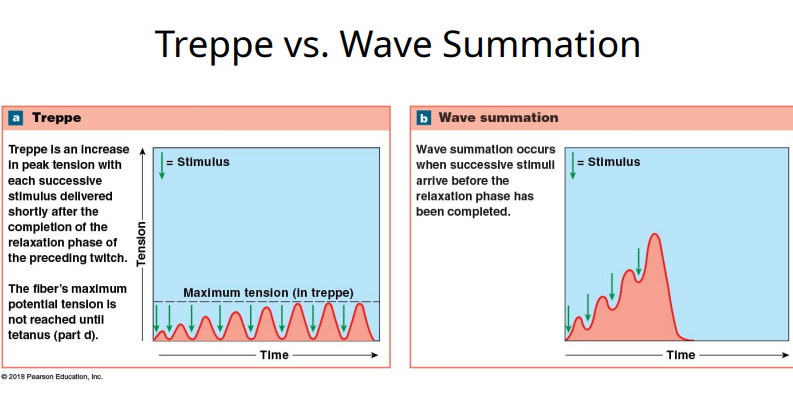
What is the difference between treppe and wave summation?
Treppe is an increase in peak tension with each successive stimulus delivered shortly after the completion of the relaxation phase of the preceding twitch.
Wave summation occurs when successive stimuli arrive before the relaxation phase has been completed.
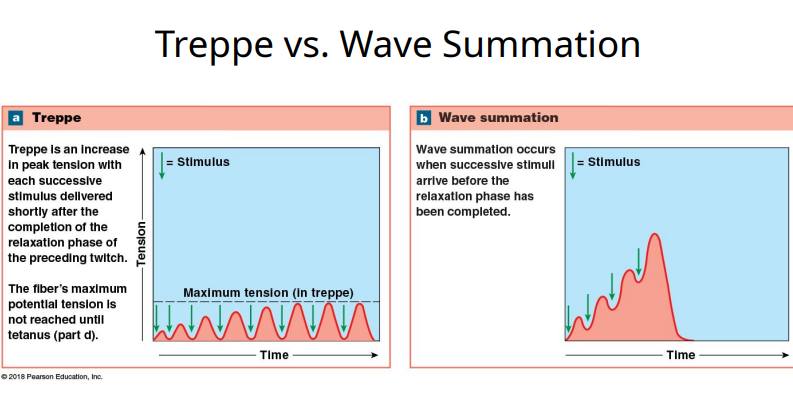
What is treppe?
Treppe is an increase in peak tension with each successive stimulus delivered shortly after the completion of the relaxation phase of the preceding twitch.
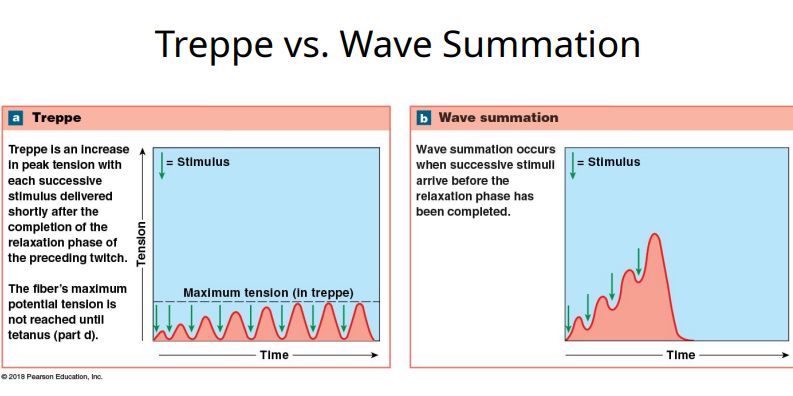
What is wave summation?
Wave summation occurs when successive stimuli arrive before the relaxation phase has been completed.
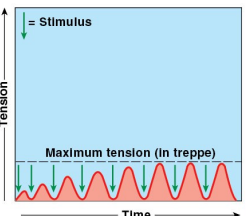
What is shown?
Treppe is an increase in peak tension with each successive stimulus delivered shortly after the completion of the relaxation phase of the preceding twitch.
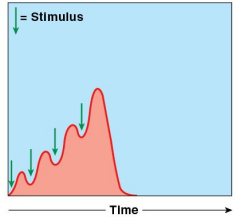
What is shown?
Wave summation occurs when successive stimuli arrive before the relaxation phase has been completed.
T/F: Wave summation occurs when successive stimuli arrive before the relaxation phase has been completed.
T
T/F: Treppe is an increase in peak tension with each successive stimulus delivered shortly after the completion of the relaxation phase of the preceding twitch.
T
T/F: Treppe occurs when successive stimuli arrive before the relaxation phase has been completed.
F. This is a description of wave summation.
T/F: Wave summation is an increase in peak tension with each successive stimulus delivered shortly after the completion of the relaxation phase of the preceding twitch.
F. This is a description of treppe.
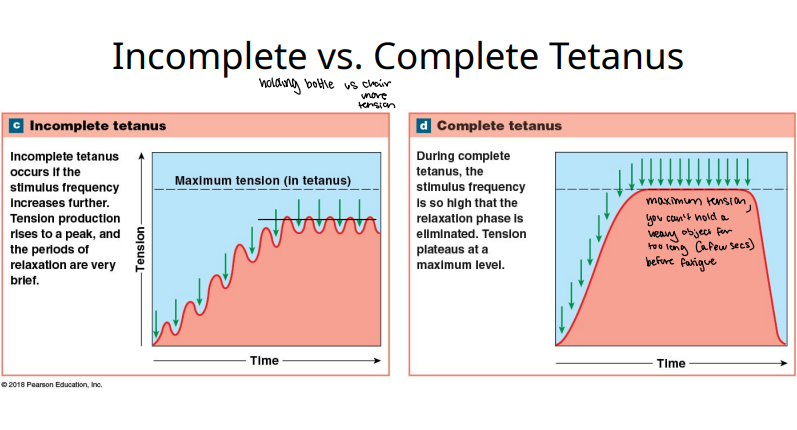
What is incomplete vs complete tetanus?
Incomplete tetanus occurs if the stimulus frequency increases further. Tension production rises to a peak, and the periods of relaxation are very brief.
During complete tetanus, the stimulus frequency is so high that the relaxation phase is eliminated. Tension plateaus at a maximum level, and there is no time for the calcium ions to to be pumped back into the sarcoplasmic reticulum (SR). This keeps the muscle constantly contracted and results in sustained, maximum force because Ca2+ remains in the cytoplasm, allowing for continuous binding to troponin and cross-bridge formation.
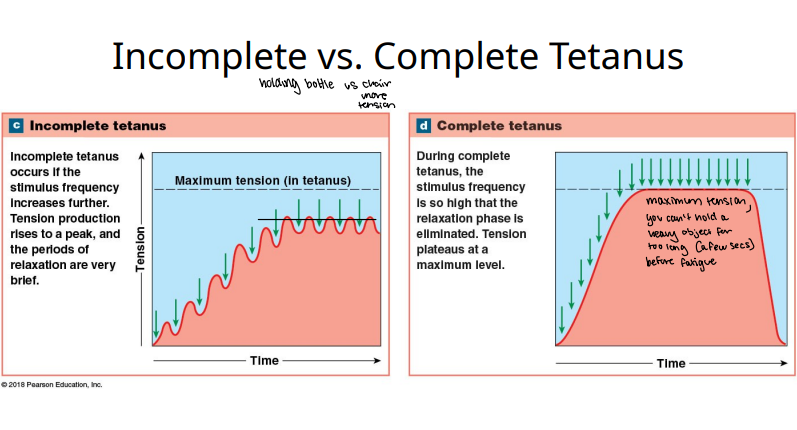
Holding a bottle vs a chair is an example of incomplete and complete tetanus because
When you hold a heavy object for a long time (a few seconds), you get fatigued (complete tetanus). Holding a chair is an example of complete tetanus. The greater weight requires significantly more muscle force, so your nervous system sends signals to the muscles at a very high frequency. The impulses arrive so rapidly that the muscle fibers do not have time to relax between contractions, causing the twitches to fuse into a smooth, sustained, and maximal-strength contraction. Whereas with a bottle, the weight is light enough that your nervous system can maintain the necessary muscle tension with a relatively low-frequency, wave-like pattern of stimulation. The muscle contracts and partially relaxes in quick, successive cycles, but the relaxation phase is not entirely eliminated.
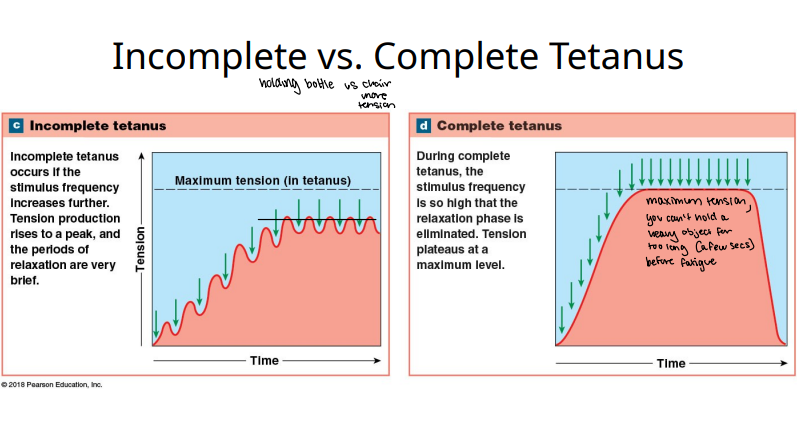
T/F: Incomplete tetanus occurs if the stimulus frequency increases further. Tension production rises to a peak, and the periods of relaxation are very brief.
T
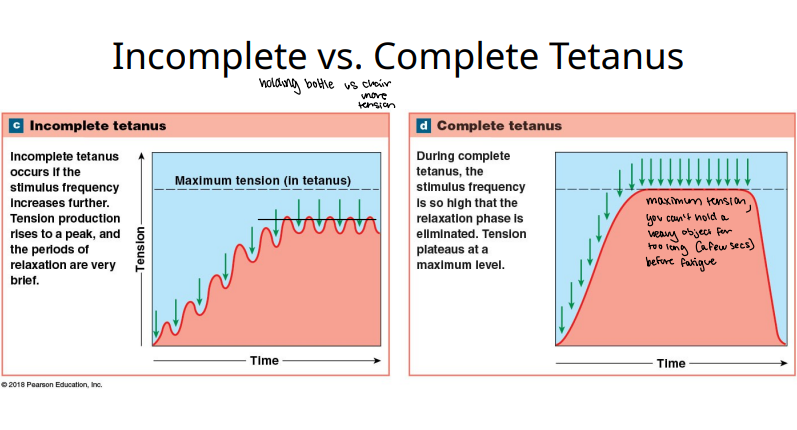
T/F: Complete tetanus occurs if the stimulus frequency increases further. Tension production rises to a peak, and the periods of relaxation are very brief.
F. this is the description for incomplete tetanus
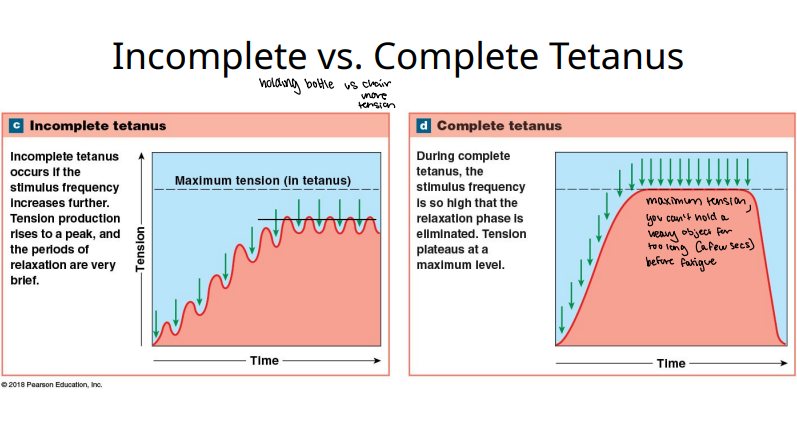
T/F: During complete tetanus, the stimulus frequency is so high that the relaxation phase is eliminated. Tension plateaus at a maximum level, and there is no time for the calcium ions to to be pumped back into the sarcoplasmic reticulum (SR). This keeps the muscle constantly contracted and results in sustained, maximum force because Ca2+ remains in the cytoplasm, allowing for continuous binding to troponin and cross-bridge formation.
T
How does incomplete tetanus differ from treppe?
Incomplete tetanus involves rapid, forceful muscle contractions with partial relaxation between stimuli, while treppe is a "staircase effect" where a rested muscle's contractions gradually increase in force with each subsequent, identical stimulus, allowing for complete relaxation between each contraction.
Treppe is an initial "warm-up" phase, whereas incomplete tetanus occurs when a muscle is stimulated too frequently for complete relaxation.
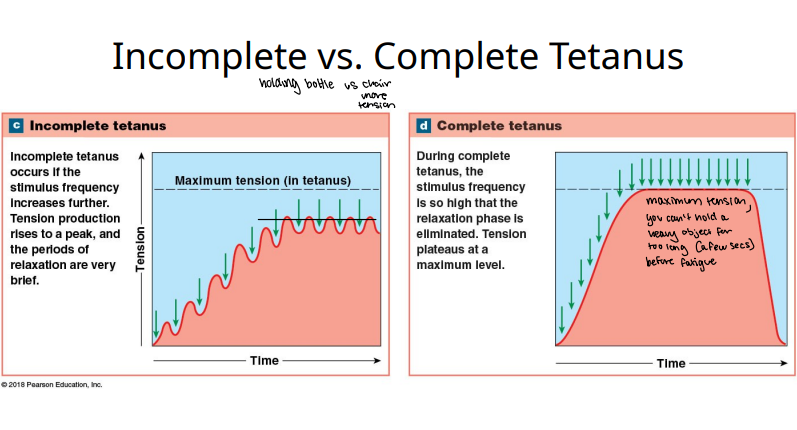
T/F: During incomplete tetanus, the stimulus frequency is so high that the relaxation phase is eliminated. Tension plateaus at a maximum level, and there is no time for the calcium ions to to be pumped back into the sarcoplasmic reticulum (SR). This keeps the muscle constantly contracted and results in sustained, maximum force because Ca2+ remains in the cytoplasm, allowing for continuous binding to troponin and cross-bridge formation.
F. This is the definition for complete tetanus
Tension produced in individual muscle fibers (cells) can vary due to
Length-tension relationship
Frequency of stimulation
Tension produced by entire muscle can vary even more widely due to
Number of muscle cells receiving nerve stimulation, commanding them to contract.
Muscle cells are grouped in motor units
Muscle cells are grouped in
motor units
What are motor units?
All the muscle fibers innervated by one motor neuron
(innervate: supply (an organ or other body part) with nerves.)
The amount of tension produced in a muscle is determined by
number of motor units activated
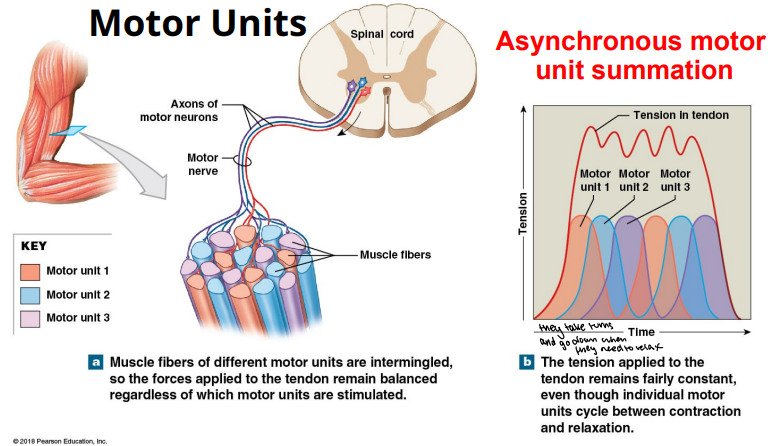
Asynchronous motor unit summation allows for sustained muscle contractions by
having different motor units fire at different times, which smooths out the force and prevents fatigue. Instead of all motor units firing at once (which would cause jerky movements), they contract and relax in an alternating pattern, so the total force remains relatively constant. This allows individual motor units time to rest and recover, enabling the muscle to maintain tension for longer periods.
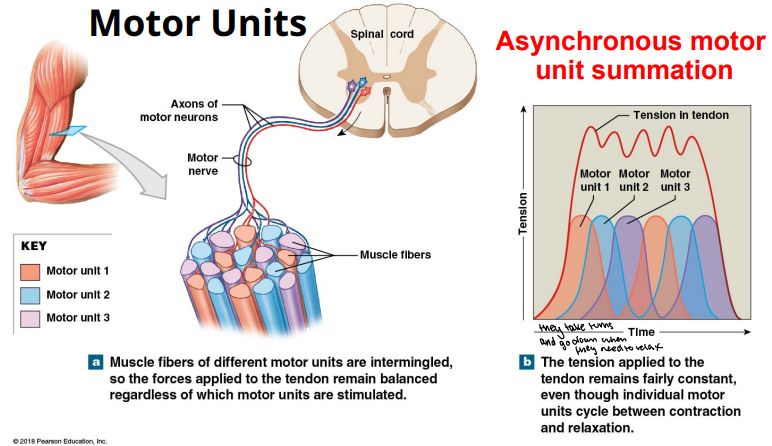
Having different motor units fire at different times, which smooths out force and prevents fatigue, is an example of what term?
asychronous motor unit summation (for sustained contractions)
*Why is it difficult to contract a muscle that has been overstretched?
Few, if any myosin-actin cross-bridges, can form when sarcomeres are overextended.
What is muscle tone?
Resting tension in a skeletal muscle
T/F: In any muscle, some motor units are always active, meaning they tense and firm the muscle.
T. Which motor units are active is constantly changing, and muscle tone is not produced by a specific subset of motor units
T/F: When a skeletal muscle is at resting tension (muscle tone), no motor units are active.
F. In any muscle, some motor units are always active, meaning they tense and firm the muscle. Which motor units are active is constantly changing, and muscle tone is not produced by a specific subset of motor units.
Why does muscle tone stabilize bones & joints?
Muscle tone stabilizes joints by maintaining a constant low-level contraction that provides resistance to passive movement, acts as a dynamic stabilizer, and helps prevent injury. This continuous tension from the muscles surrounding a joint is crucial for maintaining posture and supporting the joint's structure, especially during rest.
Greater resting muscle tone causes higher resting rate of
metabolism
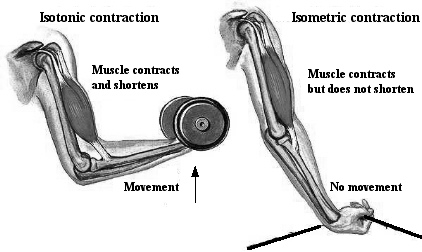
What is an isotonic contraction?
tension rises, length of muscle changes
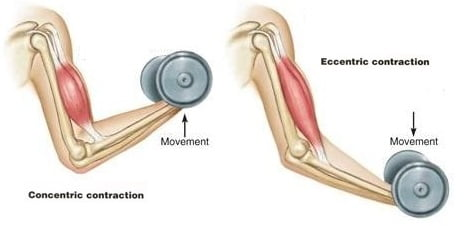
What are the 2 subtypes for isotonic contractions?
Concentric – muscle tension exceeds resistance and muscle shortens
Eccentric – peak tension developed is less than the resistance, muscle elongates
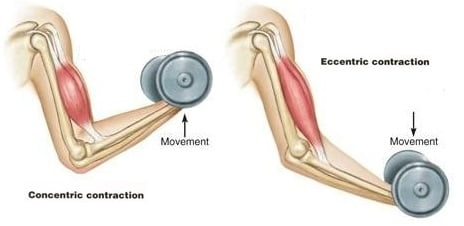
What is a concentric isotonic contraction?
Concentric – muscle tension exceeds resistance and muscle shortens
Eccentric – peak tension developed is less than the resistance, muscle elongates
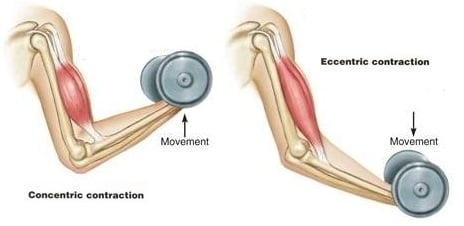
What is a eccentric isotonic contraction?
Eccentric – peak tension developed is less than the resistance, muscle elongates
Concentric – muscle tension exceeds resistance and muscle shortens
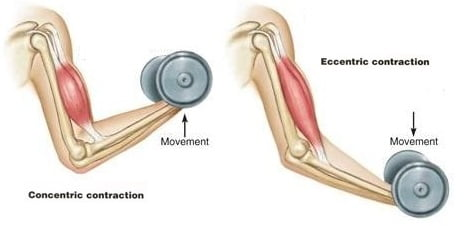
Peak tension developed is less than the resistance, muscle elongates. What type of isotonic contraction is this?
Eccentric
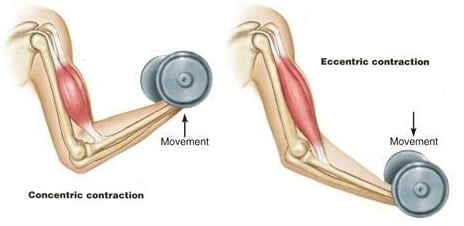
Muscle tension exceeds resistance and muscle shortens. What type of isotonic contraction is this?
Concentric
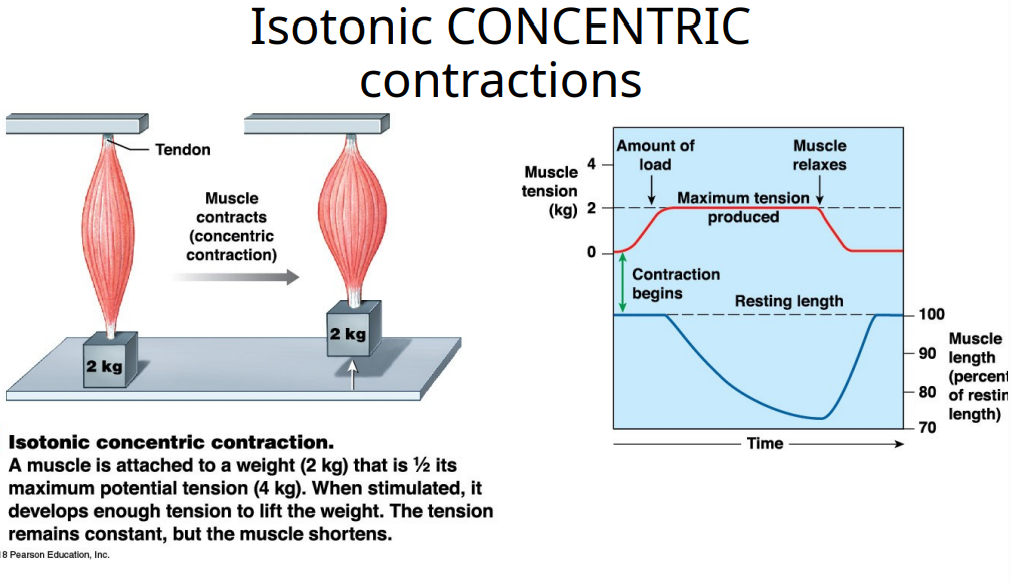
A muscle is attached to a weight (2kg) that is 1/2 its maximum potential tension (4kg). When stimulated, it develops enough tension to lift the weight. The tension remains constant, but the muscle shortens. What type of isotonic contraction is this?
Concentric
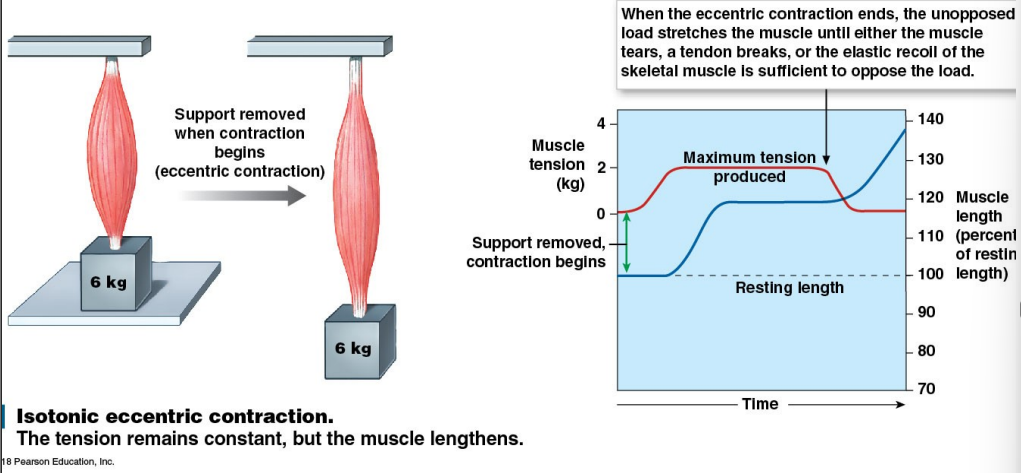
A muscle is attached to a weight (2kg) that is 1/2 its maximum potential tension (4kg). When stimulated, it develops enough tension to lift the weight. The tension remains constant, but the muscle lengthens instead of shortens. What type of isotonic contraction is this?
Eccentric
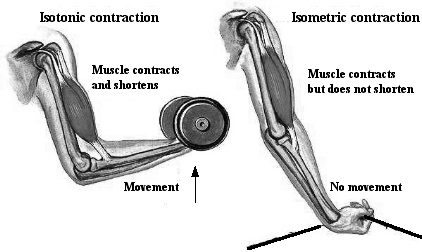
What is an isometric contraction?
Isometric - tension rises, length of muscle remains constant.
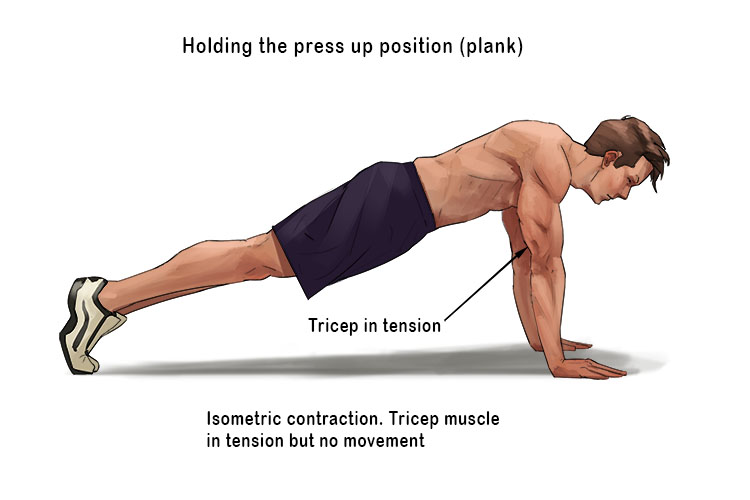
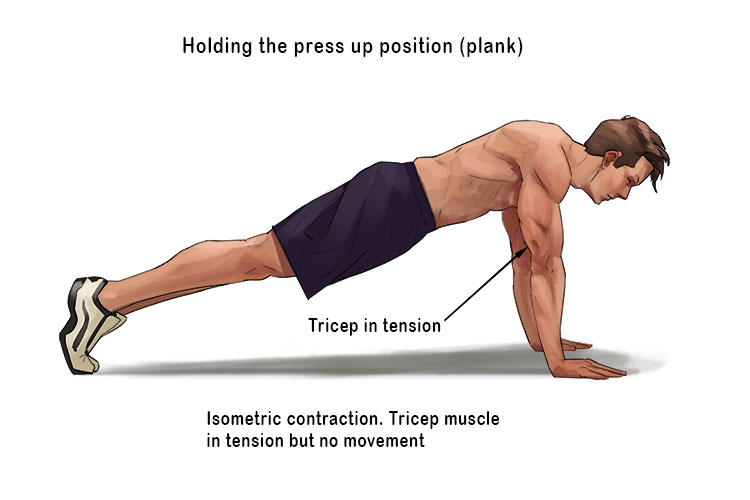
The tension produced never exceeds resistance.
The muscle as a whole does not shorten but individual muscle fibers shorten until internal connective tissues and tendons are taut (stretched or pulled tight).
Cannot shorten further because tension does not exceed resistance.
What kind of contraction am I describing?
Isometric - tension rises, length of muscle remains constant.
T/F: There is no active mechanism for muscle fiber elongation.
T. A muscle cell does not cause itself to lengthen after contraction process ends.
There is no active mechanism for muscle fiber elongation. A muscle cell does not cause itself to lengthen after contraction process ends. It returns to resting length due to what?
Muscle fibers actively contract (shorten) through the sliding filament mechanism, where actin and myosin filaments slide past each other.
However, they do not actively lengthen themselves — there’s no mechanism inside the muscle cell that pushes the filaments apart again.
So, when contraction ends, a muscle returns to its resting length because of external forces, not because the muscle “uncontracts” itself.
Those external forces include:
Elastic recoil – the connective tissue around the muscle (like tendons) and within the muscle (like titin proteins) naturally recoil when tension is released.
Opposing muscle contraction – muscles usually work in antagonistic pairs (like biceps and triceps). When one contracts, the other is stretched and lengthens passively.
Gravity – in some cases, gravity helps pull a limb or body part back to its resting position.
Recoil in elastic components in connective tissue
Contraction of opposing muscle groups
Gravity
Muscle contraction requires large amounts of
ATP
Because muscle cells store only enough high energy molecules to sustain contraction until additional ATP can be generated (ATP & Creatine phosphate reserves last 15 secs once contraction begins), the muscle cell must
must make new ATP through other metabolic pathways, and generate ATP at approx the same rate as it is used for remainder of contraction
The muscle cell must generate ATP at approximately the same rate as it is used for the remainder of
contraction
How long do ATP and creatine phosphate reserves last once contraction begins?
15 secs
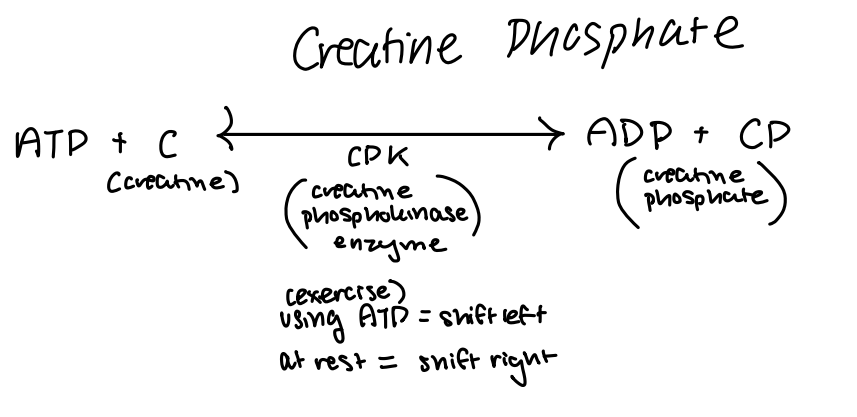
What do creatine phosphate reserves consist of?
ATP is not used for long term storage for energy,
So at rest, the muscle cell makes more ATP than needed, and extra ATP transfers a high energy phosphate to creatine for storage.
So then, CP reserves releases stored energy to convert ADP to ATP when ATP is needed at start of contraction
T/F: Only aerobic cellular respiration is needed to generate additional ATP for peak performance.
F. Aerobic AND anaerobic glycolysis is needed to generate additional ATP for PEAK performance.
What type of metabolic pathways are needed to generate additional ATP for peak performance?
Aerobic and anaerobic glycolysis pathways
What metabolic mechanism uses O2 and releases CO2?
aerobic cellular respiration (O2 is used at ETC and CO2 released during Krebs)
This cycle occurs in the mitochondria and produces CO2, what metabolic cycle is this?
Citric acid
Where is ATP synthesis done for aerobic metabolism and also when O2 is used?
Electron Transport Chain
Resting muscle fibers rely on the aerobic metabolism of ______ ___ to generate ATP.
fatty acids
What do resting muscle fibers rely on to generate ATP?
Aerobic metabolism of fatty acids
Excess ATP is used to store glucose into glycogen, which creates what?
creatine phosphate
Excess ATP is used to store glucose into ____, which creates what?
glycogen; creatine phosphate
Describe how fatty acids are used to generate ATP for resting muscle fibers (aerobic metabolism)
FA is absorbed from circulation
Broken down to 2-carbon units of Acetyl-coA which enters directly into the citric acid cycle
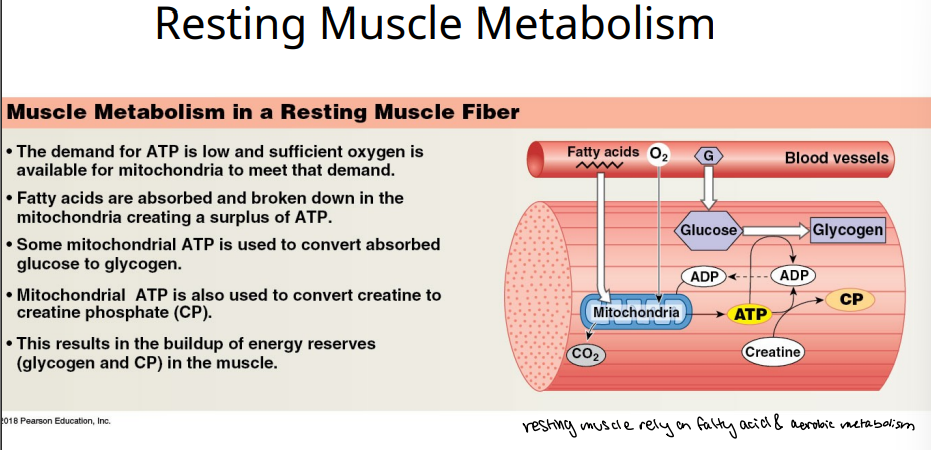
The demand for ATP is low and suficient oxygen is available for the mitochondria to meet that demand in a resting muscle fiber. What then gets absorbed and broken down in the mitochondria to create a surplus of ATP?
Part two:
Some mitochondrial ATP is used to convert creatine to ____ ___.
What does this result in?
fatty acids; creatine phosphate; this results in the buildup of energy reserves (glycogen and CO) in the muscle.
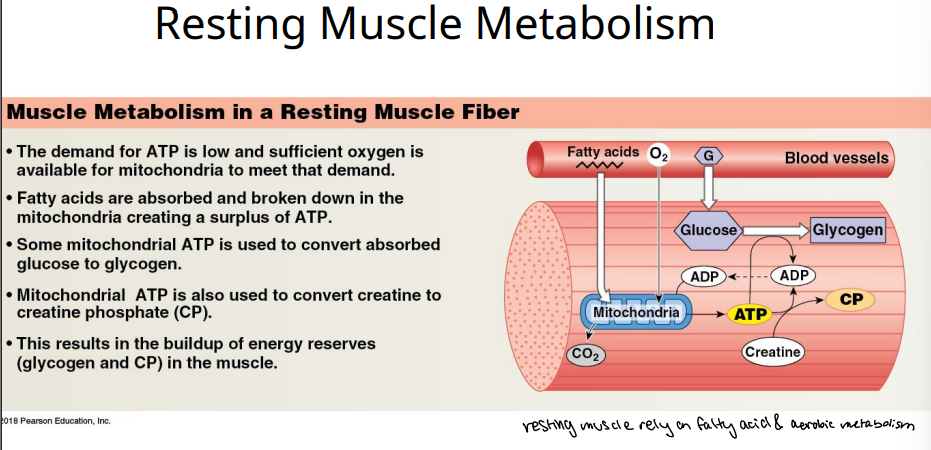
Some mitochondrial ATP is used to convert creatine to
creatine phosphate
Contracting muscle fibers rely on aerobic anaerobic metabolism of ____, but the amount of aerobic vs anaerobic metabolism depends on
glucose; the intensity of the muscle contraction (moderate vs peak?)
Intensity of the muscle contraction can be categorized into moderate vs ___.
peak
Glucose comes from the circulation & breakdown of
glycogen reserves within a muscle cell
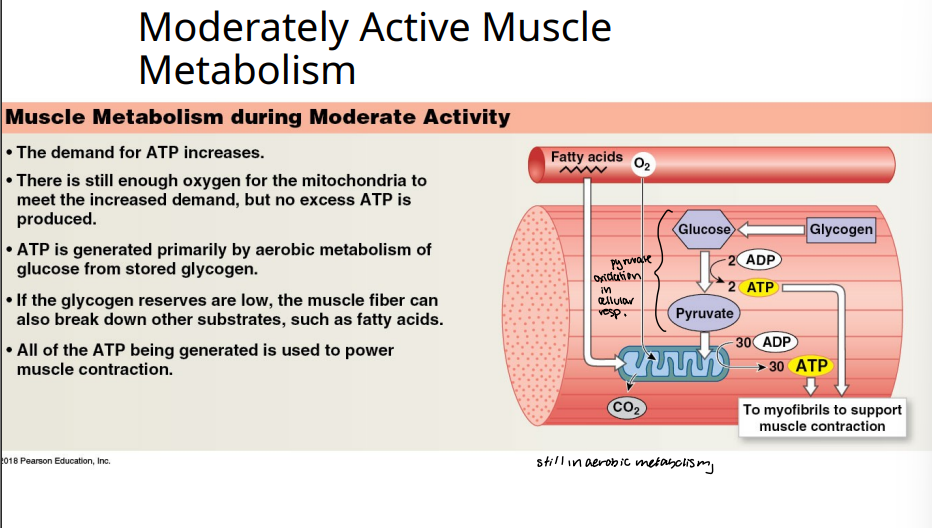
What is muscle metabolism like during moderate activity?
The demand for ATP increases
There is still enough O2 for the mitochondria to meet the increased demand, but no excess ATP is produced
ATP is generates primarily by aerobic metabolism of glucose from stores glycogen
If the glycogen reserves are low, the muscle fiber can also break down other substrates, such as fatty acids.
All of the ATP being generated is used to power muscle contraction.